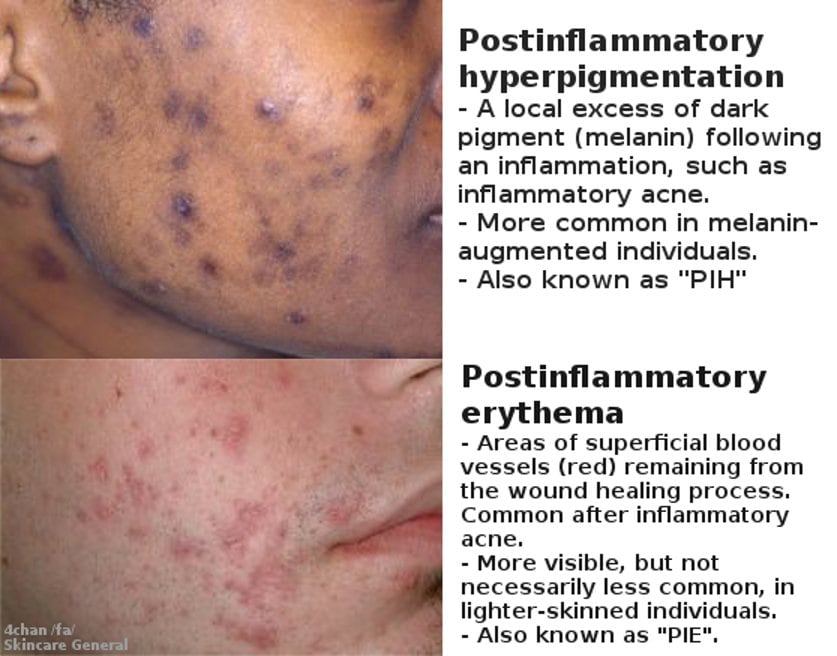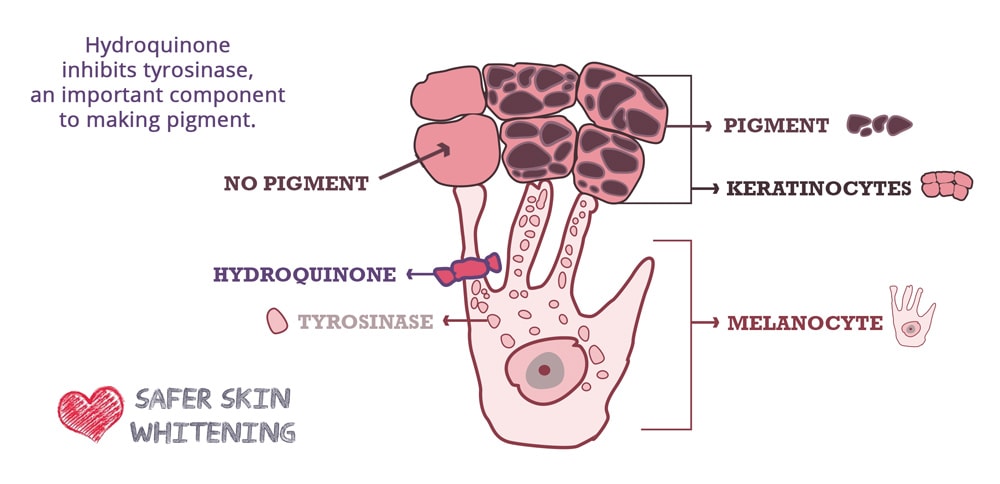Post-inflammatory Hyperpigmentation and Everything You Need to Know
Dealing with injuries and other inflammatory skin conditions is not easy. It can take a real toll on your health, finances, and comfort, not to mention your confidence. And just when you think you are done, the tell-tale signs kick in; unsightly hyperpigmentation that stands out like that dent that reminds you your car was in an accident.
Unfortunately, the ‘territorial’ marks remain long after the skin injuries have healed. This is called post inflammatory hyperpigmentation. It can make you very self-conscious, not to mention the part where it sends your confidence down the drain.
How much do you actually know about PIH? Having the right information at your fingertips can help you know how to deal with the situation. Here is information on post inflammatory hyperpigmentation and everything you need to know.
What is Post inflammatory Hyperpigmentation?
Post-inflammatory hyperpigmentation is darkening of parts of the skin that occurs when skin heals after suffering injury. PIH manifests as macules, or patches of hyperpigmented skin that range from shades of brown to shades of black depending on the tone of the skin and where they are located in the skin. The closer they are to the surface of the skin, the lighter they are and vice versa.
Is PIH the same as PIE?
PIH is often times confused with Post Inflammatory Erythema (PIE). However, the two of them are different. While both result from inflammation as their names suggest, PIH is caused by excess melanin production while PIE is caused by excess blood flow to the site of inflammation.

Image credit: Reddit
PIE occurs when blood capillaries below the skin break, leading to the production of excess blood meant to heal the vascular injury. This leads to the formation of patches that appear reddish pink on the skin. When you put pressure on them, they temporarily disappear.
How Does PIH Occur? Where does PIH affect?
When there is cutaneous injury or inflammation in the skin, inflammatory mediators and other substances released during the inflammatory process cause an increased production of melanin.
The excess melanin is dispersed into the skin cells surrounding the site of the injury which leads to epidermal hypermelanosis or simply, hyperpigmented skin. Unfortunately, the tell-tale hyperpigmentation remains even after the injuries are healed. PIH can affect the face and any part of the body.
What Causes Post inflammatory Hyperpigmentation?
PIH is caused by excess melanin production which results from an injury or trauma that causes the skin to be inflamed. The most common conditions associated with PIH are acne, lichen planus, systemic lupus erythematosus, chronic dermatitis, allergic reactions, and other inflammatory skin conditions.
PIH is not just about skin conditions; procedures like microdermabrasion, chemical peels, laser therapy, shaving, excess exfoliation and other treatments that use electromagnetic devices can also lead to it. Other body injuries such as scratches, bug bites, and mechanical injuries are also great contributors.
Who Gets PIH?
PIH can occur in people of all ages and genders. While it also affects people of all races, people with darker skin have increased incidence compared to their lighter-skinned counterparts.
How long does PIH last? Does it go on its own?
If you have the patience of a saint, PIH will eventually go away on its own through the skin’s natural regeneration process. This may take somewhere between 3-24 months or more depending on factors such as age, how severe it is, the underlying cause, your skincare routines and skin tone among other factors.
RELATED READING:
Best Products for Skin Lightening
How to prevent Post-inflammatory Hyperpigmentation?
The formula of PIH is “inflammation + melanin= PIH”. Your best bet lies in eliminating inflammation. How you do that is another story altogether because sometimes trouble just seems to find you. Think of pesky bugs, scratchy pets and itchy bumps! While you cannot eliminate 100% of inflammation triggers around you, the following tips can help you halt some extra melanin synthesis:
-
Use an SPF 30 or higher sunscreen every time you venture out in the sun or avoid exposure by wearing UV protective clothing. While the sun does not cause PIH, exposure is known to aggravate the situation.
-
If you have acne or an itchy skin condition, avoid popping, scratching or disturbing your skin in any way.
-
Use moisturizers and other mild formulations to soothe itchy skin conditions like eczema, dermatitis, allergies and insect bites
-
Keep away from harsh, skin-irritating products
-
Treat skin conditions that lead to PIH before they aggravate. Additionally, you can use treatments that also double as anti-inflammatories e.g. use of Azelaic acid to treat acne.
How is PIH Treated and for how Long?
PIH is treatable. However, the time it takes to completely reverse the condition may vary across individuals. An approximate time would be 6-12 months, give or take. The earlier it is treated, the faster the results.
rocket
Note: Before treatment even begins, any underlying skin conditions should be dealt with first.
Different PIH treatments employ several strategies:
-
Inhibiting/ stopping melanin production
-
Hastening the skin natural skin regeneration process
-
Exfoliating the skin to reveal newer and lighter cells
-
Brightening the skin complexion
To give great results, PIH treatments can be used alone or in combinations. Here are some of the most common treatments:
Chemical peels
This involves the application of chemical solutions on the skin to get rid of dead cells and stimulate the growth of new ones. Alpha Hydroxyl Acids (AHAs) such as glycolic and salicylic are commonly used in these treatments.
While they have been proven to be effective and well tolerated, care should be taken on the concentration and how long they are left on the skin as the acids are also associated with irritation which can make the situation worse.
Chemical peels can be done by a dermatologist but kits for use at home are also available. Skin type, allergies and sensitivities should be taken into account before use.
Laser Therapy
Laser skin whitening employs the use of targeted light beams to effectively get rid of hyperpigmentation. The dermatologist has control over the intensity of the treatment. Depending on the severity of hyperpigmentation, the treatment can work on the epidermal layer of your skin or penetrate the deeper layers.
Depending on the intensity of the treatment, the lasers can either in your dermis to promote collagen or remove several layers of your skin. There is a downside to this treatment; it can cause the skin to darken in some people and therefore requires proper selection of options based on skin type.
Retinoids
Retinoids are derivatives of vitamin A. They brighten the skin by speeding epidermal turnover, consequently aiding the dispersion and removal of melanin. They also boost collagen and get rid of free radicals.
Retinoids are known to cause irritation at first which can make PIH worse but they are known to be effective. It would help to start with a lower strength and then increase the amount and frequency.
Hydroquinone
This is the most common ingredient in skin pigmentation products. It works by inhibiting melanin production. As effective as it is, Hydroquinone comes with a bagful of controversies. After being associated with ochronosis and other dangerous effects, it has been banned or restricted for use in cosmetic products in several countries and regions.

In most places where it is allowed, only 2% can be sold over the counter while strengths beyond this are sold on prescription. Still, it holds the place of the ‘gold standard’ for use in skin lightening.
Natural treatments
These treatments make use of natural melanin-inhibiting ingredients such as bearberry extracts, liquorice root extracts, papaya, citrus extracts, kojic acid, gigawhite, Indian gooseberry, vitamin B3 (Niacinamide) and mulberry extract among others.
Some of these ingredients also come with moisturizing, anti-inflammatory, anti-ageing, and, anti-oxidising properties. They can be used in their natural state but they are easier to obtain and use when they are incorporated in skin lightening products such as creams, serums, soaps, scrubs, washes etc.
rocket
Note: Photoprotection is a very important part of any treatment that you choose. Skin depigmenting treatments increase your skin’s photosensitivity. Apart from this, exposure to sunlight makes PIH worse as mentioned above.
It would, therefore, be counterproductive to try treating PIH without shielding your skin from the sun. Just like in the preventive measure, use sunscreen with SPF of at least 30 and also take other protective measures.
Conclusion
PIH is darkening of the skin on the site of a healed injury or trauma. It is characterized by dark patches that range from shades of brown to shades of black. People of all ages and gender can get PIH but is more prevalent in dark-skinned people.
PIH is different from PIE. The former occurs as a result of excess melanin production after an injury while the latter occurs as a result of excess blow flow after a capillary break below the skin. PIH can affect the face and other parts of the body and lasts long after the injuries are healed.
The best preventive measure against the condition is keeping away inflammation. Once it occurs, it can fade on its own but it may take up to years to clear. There are treatments that can help to give you faster and better results. Among them are chemical peels, retinoids, laser therapy, hydroquinone and natural depigmentation treatments.
About:
sonia knight
Sonia Knight is the founder of be:skinformed.
Apart from having her own experience with hyperpigmentation, Sonia has gained vast knowledge in the dermatology field. For more info on this, check out our about us page.




